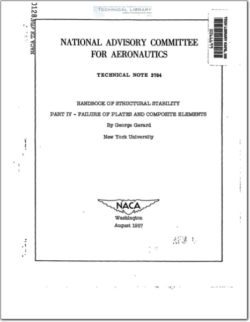NACA-TN-3784

- Version
- 378 Downloads
- 3.52 MB File Size
- 1 File Count
- December 4, 2015 Create Date
- December 4, 2015 Last Updated
National Advisory Committee for Aeronautics, Technical Notes - Handbook of Structural Stability Part IV - Failure of Plates and Composite Elements

Available theories on failure of flat plates are reviewed. In
terms of the results of these theories, available test data on the post-
buckling behavior, effective width, and failure of flat and curved plates
are correlated.
Test data on the crippling strength of various formed and extruded
shapes are reviewed, from which a generalized method of crippling analysis
is formulated. The effects upon the crippling strength of alclad coatings
and the increased properties in the corners of formed sections are inves-
tigated by use of this analysis.
The generalized crippling analysis was applied to a variety of sec-
tions and materials in common use. It was found that the crippling
strength of all the sections is governed in a simple manner by the devel-
oped length-thickness ratio and number of corners of the section.
The present report is concerned with the failure of flat and curved
plates and composite elements which are subject to buckling under compres-
sive loads. For composite elements such as Z- or channel sections, the
failure mode considered is that commonly referred to as crippling. Thus,
the effective slenderness ratio of the composite elements is in the neigh-
borhood of 20, a region in which variations in length result in negligible
changes in the crippling strength.
In the section entitled "Basic Principles" the postbuckling behavior
of columns, plates, and cylinders is briefly reviewed in order to deter-
mine those elements for which the failure load may considerably exceed
the buckling load. Because of the mathematical complexities inherent in
any theoretical treatment of the failure phenomenon, the available theories
constitute an important contribution to the understanding of the factors
operative at failure. Therefore, a comprehensive review of results
obtained for hinged flanges is presented in the next section. This anal-
ysis serves as a reference frame from which semiempirical methods can be
devised to treat failure of elements not amenable to theoretical solution.
| File | Action |
|---|---|
| naca-tn-3784.pdf | Download |

Comment On This Post